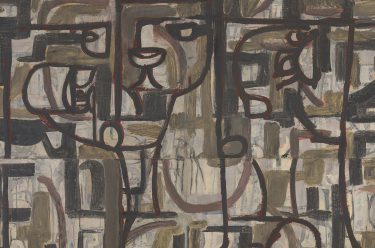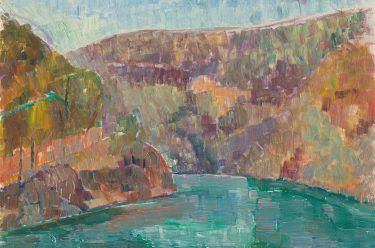On display in the Australian Art Collection, Queensland Art Gallery (Josephine Ulrick and Win Schubert Galleries), Photographic machine 1968 (illustrated) by Australian artist Erica McGilchrist — whose career can be defined by the freedom with which she explored different styles and directions — was a passionate activist for women’s art, and ahead of her time.
Erica McGilchrist was highly regarded as an artist and educator, celebrated for her contributions to modernism in Australia from the late 1950s until her passing in 2014. She was born in Mount Gambier, South Australia, in 1926 but for most of her career lived and worked in a studio in the Melbourne suburb of Caulfield, creating countless paintings, works on paper and embroideries.
McGilchrist was a passionate activist for women’s art. In 1975 she co-founded the Women’s Art Register, which she coordinated until 1986, and she was widely acknowledged as an important community figure for this advocacy. She was awarded the Order of Australia Medal in 1992 for her outstanding contribution to the women’s art movement and in recognition of her own art practice. The Register is now housed at the Richmond Public Library in Melbourne and holds reference material on more than 5000 Australian and international women artists.
A period of study at the Akademie der Bildenden Kunste in Munich from 1960–61, made possible by a scholarship from the German Academic Exchange Service, was integral to McGilchrist’s development and also enabled her to exhibit in both Munich and London before returning to Australia in 1964. Yet it was more than having access to the climate of artistic innovation in Europe that shaped the artist at this time. Her travel was said to have come with strained romantic relationships in Australia and Europe, and the resultant emotional burden may have also prompted McGilchrist to experiment and invent freely.1 Improvised and uncensored, she held a deepening interest in surrealist automatism, as well as various modes of lyrical abstraction and figurative expressionism. In many respects, this sense of freedom continued throughout McGilchrist’s career — and perhaps even defines it. Linda Short, curator of the artist’s 2013 survey at Heide Museum of Modern Art, says that
McGilchrist typically allowed the mood or meaning informing her images to dictate her stylistic approach. As a result, she worked fluidly between abstraction and figuration, and often combined both modes in the one picture. . . McGilchrist’s ability to invoke feelings and states of mind through formal means is one of the strengths of her art, yet she always balanced the emotive tenor of her work with an intellectualism.2
Erica McGilchrist Photographic machine 1968

McGilchrist was arguably ahead of her time in taking such latitude and giving herself the necessary space to develop her interest in the human psyche, exhibiting more in common with postmodern artists of the late 1970s and 1980s than her immediate peers in the 1960s. Moreover, her engagement with broad feminist concerns — and her interest in the relationship between the individual and society — makes her work particularly relevant today.
For all McGilchrist’s fluid tactics, Photographic machine 1968 is a keenly resolved painting, with a clear design sensibility owing to an economic use of colour, line and pattern. Her repeating bars — and use of clean, straight lines in general — makes a skilful contrast against the sparing use of curves that denote two arms and a head engaged in the choreography of taking a photograph. In this balance of abstraction and representation, formal clarity and colour harmonies, Photographic machine has something in common with a particular European modernist sensibility, as found in the wit of Sophie Taeuber-Arp’s earlier take on Dadaism.
It is evident in her eloquence and clarity that McGilchrist delighted in her aesthetic explorations — both in Photographic machine and indeed throughout her career. While her works were broad in shape, her thoughtful character remained ever present.
Peter McKay is Curatorial Manager, Australian Art, QAGOMA
This text is adapted from an essay first published in QAGOMA’s Members’ magazine, Artlines.
Endnotes
1 Linda Short, ‘Erica McGilchrist’, Monash University Museum of Art, <https://www.monash.edu/muma/collection/level-2-page/Firstlanguages-of-the-Collection/2019/Erica-McGilchrist>, viewed June 2019.
2 Short, ‘Erica McGilchrist’.
#QAGOMA


